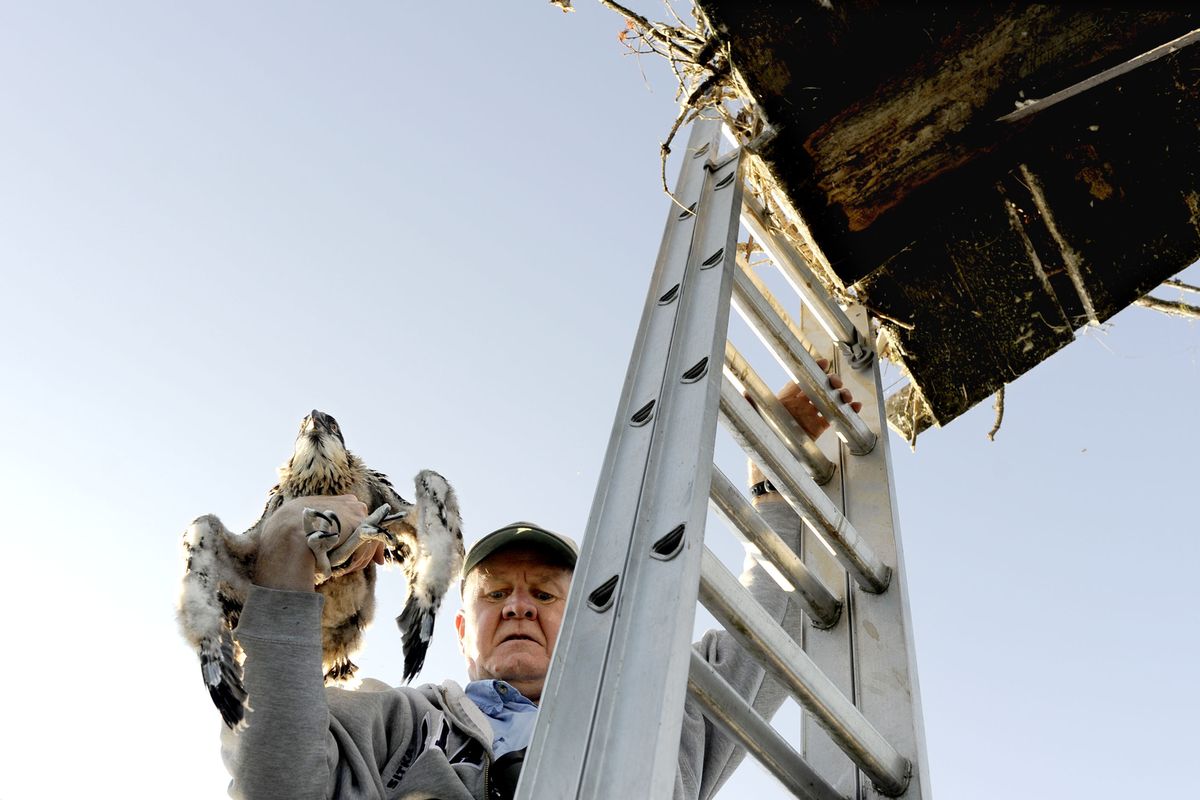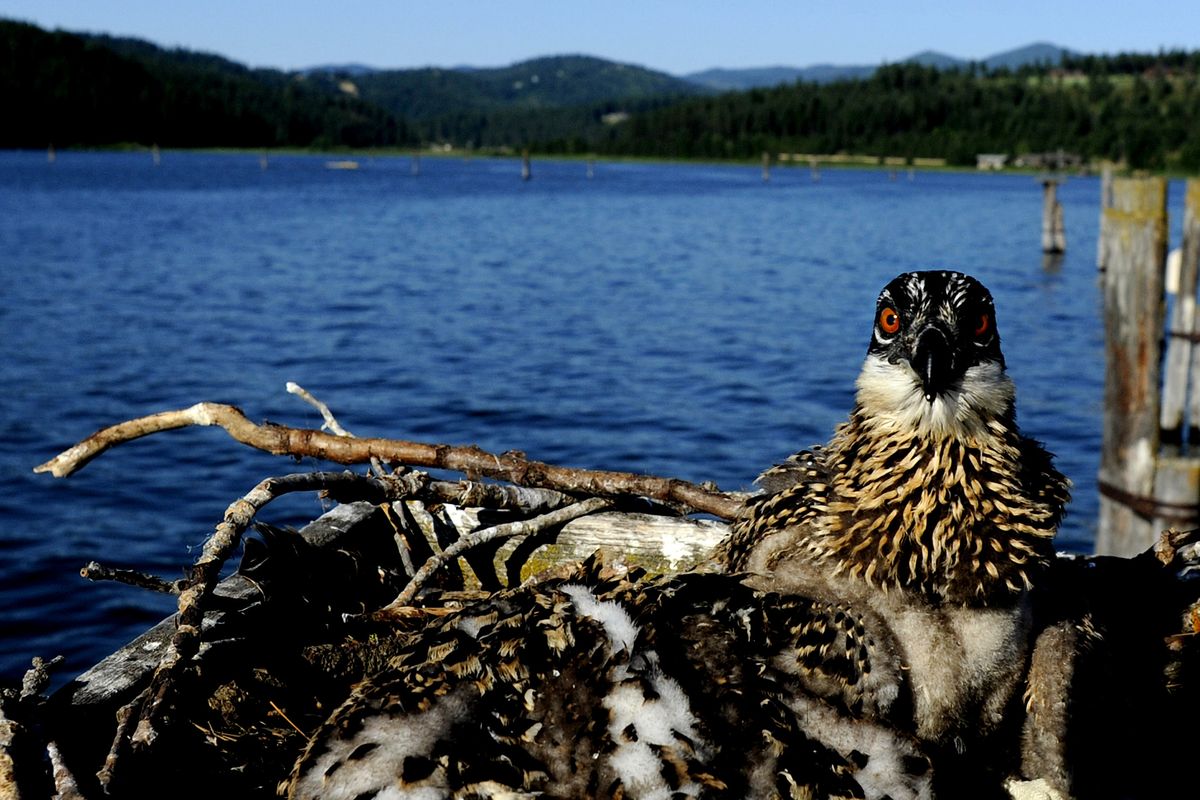Man studies region’s ospreys for four decades
A juvenile osprey nests above Lake Coeur d’Alene on July 13. North Idaho has the largest nesting population of ospreys in the West. (Kathy Plonka)Buy a print of this photo
As an adult osprey circled overhead, Wayne Melquist perched an extension ladder against a piling in Cougar Bay and scrambled up to the nest.
“There’s two here – one big enough to band,” he called down to others in the pontoon boat. As Melquist attached an aluminum band to a wriggling young osprey’s leg, boat operator Ross Walkinshaw worked to keep the craft from rocking in the wind that swept across Lake Coeur d’Alene.
For more than 40 years, Melquist has been making precarious ascents to band juvenile ospreys.
The long-running research project offers valuable insight into the lives of the majestic birds, which raise their young on the region’s lakes and rivers but winter in Mexico and Central America. Melquist’s work has shed light on nesting patterns, migration routes, population densities and interchange with other osprey populations.
“Long-term data sets like that are pretty nice to have, but pretty rare,” said Chip Corsi, regional supervisor for the Idaho Department of Fish and Game in Coeur d’Alene.
While short-term studies offer a snapshot look at wildlife populations, it often takes decades of data for trends to emerge, he said. Each band is marked with an identification code and a phone number for people to call when they find a dead bird. The data goes into a national registry for research.
Melquist has banded about 2,500 osprey nestlings since 1972, when his graduate adviser at the University of Idaho got him involved in the project. Melquist, 65, continued the banding during a long career at Idaho Fish and Game. Since his retirement, he’s continued the work as a consultant.
As the pontoon boat approached another piling in the bay, an adult female left the nest with a keening cry.
“She knows him. They all do,” quipped Walkinshaw, who frequently provides boat transportation for Melquist’s banding excursions.
“Sometimes, you almost think they do,” Melquist said.
He’s had adult ospreys fly out toward him when he was still 300 yards from the nest. “They make a beeline out to greet you,” Melquist said, “almost like they knew what was happening.”
But that might be anthropomorphic thinking, he cautioned. “I can’t prove it.”
Ospreys fascinate Melquist. Often called fish hawks, ospreys are a distinct species among birds of prey. They have a flexible talon, which allows them to grasp fish with two talons forward and two back. Rough, wart-like nodules on their feet help them hold on to thrashing fish.
Their dramatic, feet-first dives to pluck fish out of shallow waters are crowd-pleasers. Melquist often finds himself wondering about the keenness of eyesight that allows ospreys to dive so accurately.
More than 200 pairs nest in the Idaho Panhandle, which has one of the largest populations in the Western United States. Melquist credits the region’s abundant waterways, good fishing and the birds’ adaptability. With fewer cottonwood snags available for nesting sites, ospreys are nesting on pilings, utility poles, bridges and even cellphone towers.
Between 2004 and 2010, more than 100 young ospreys from North Idaho were relocated to South Dakota to re-establish populations along the Missouri River.
The juveniles Melquist is banding aren’t flying or fishing yet. Each futile flap of their wings releases a small spray of downy feathers similar to dandelion fluff.
The youngsters are molting. Eventually, they’ll lose the creamy-tipped feathers that help camouflage them in the nest and sport dark brown adult feathers instead. Their reddish eyes will turn gold.
When Melquist started banding in the early 1970s, ospreys and other raptor populations were threatened by the pesticide DDT, which caused their eggshells to break. A ban on DDT use in the United States has led to a rebound in numbers, though ospreys are probably still exposed to some level of the pesticide in their wintering grounds, Melquist said. DDT continues to be used in other countries because of its effectiveness in controlling malaria-transmitting mosquitoes.
Most of the current threats to North Idaho’s ospreys are human-caused, Melquist said. He plucks wads of string and fishing line out of nests and frees young birds that get tangled up in the line. He’s also shooed oblivious fishermen away from nesting sites.
When people encroach on nesting sites, they keep adult birds from returning to the nest to incubate eggs or feed young.
Even after four decades of study, plenty remains unknown about the region’s ospreys, Melquist said. The birds begin heading south in late August and September, with the juveniles departing after the adults. Melquist wonders how the young birds know where to go.
“They’re on their own to find a travel route,” he said.



